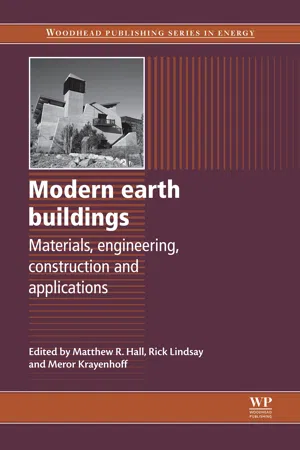
Modern Earth Buildings
Materials, Engineering, Constructions and Applications
- 800 pages
- English
- ePUB (mobile friendly)
- Available on iOS & Android
Modern Earth Buildings
Materials, Engineering, Constructions and Applications
About This Book
The construction of earth buildings has been taking place worldwide for centuries. With the improved energy efficiency, high level of structural integrity and aesthetically pleasing finishes achieved in modern earth construction, it is now one of the leading choices for sustainable, low-energy building. Modern earth buildings provides an essential exploration of the materials and techniques key to the design, development and construction of such buildings.Beginning with an overview of modern earth building, part one provides an introduction to design and construction issues including insulation, occupant comfort and building codes. Part two goes on to investigate materials for earth buildings, before building technologies are explored in part three including construction techniques for earth buildings. Modern earth structural engineering is the focus of part four, including the creation of earth masonry structures, use of structural steel elements and design of natural disaster-resistant earth buildings. Finally, part five of Modern earth buildings explores the application of modern earth construction through international case studies.With its distinguished editors and international team of expert contributors, Modern earth buildings is a key reference work for all low-impact building engineers, architects and designers, along with academics in this field.
- Provides an essential exploration of the materials and techniques key to the design, development and construction of modern earth buildings
- Comprehensively discusses design and construction issues, materials for earth buildings, construction techniques and modern earth structural engineering, among other topics
- Examines the application of modern earth construction through international case studies
Frequently asked questions
Information
Overview of modern earth building
Abstract:
1.1 Introduction

1.2 Definition of modern earth building
Table of contents
- Cover image
- Title page
- Table of Contents
- Copyright
- Contributor contact details
- Woodhead Publishing Series in Energy
- Preface
- Part I: Introduction to modern earth buildings
- Part II: Earth materials engineering and earth construction
- Part III: Earth building technologies and earth construction techniques
- Part IV: Modern earth structural engineering
- Part V: Application of modern earth construction: international case studies
- Appendices
- Index